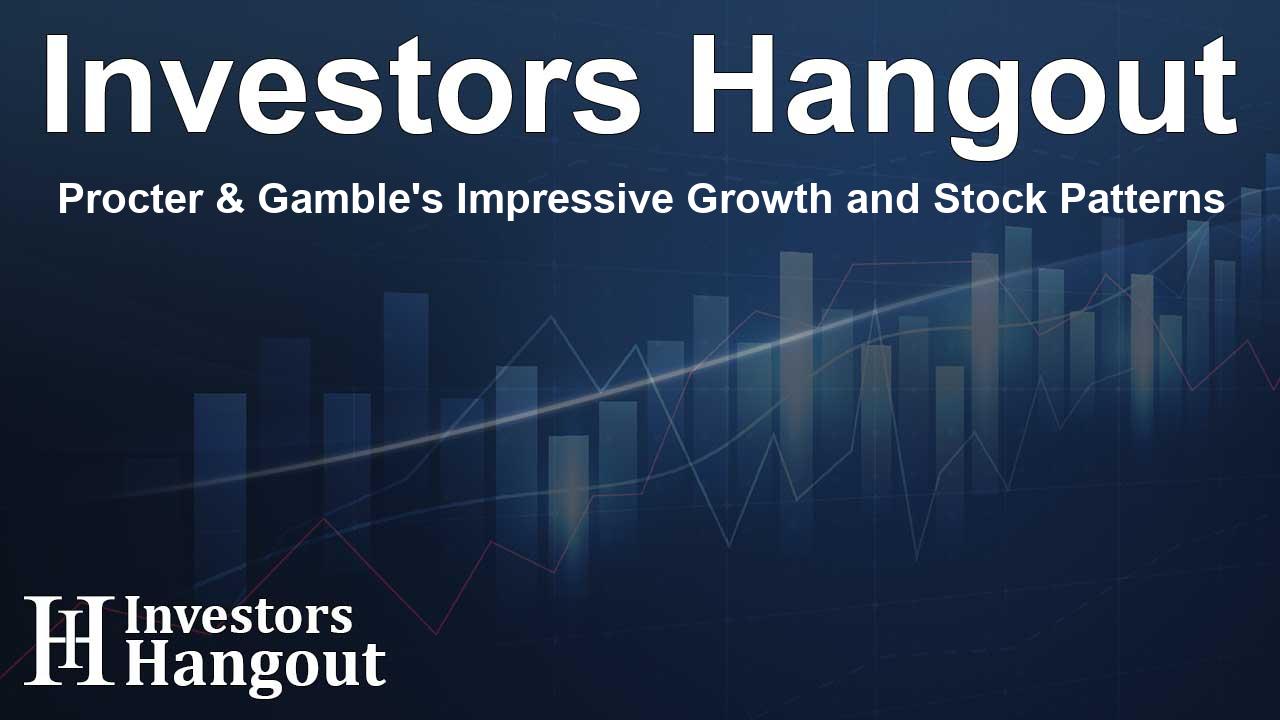Procter & Gamble's Impressive Growth and Stock Patterns

Procter & Gamble's Continued Success in Consumer Products
Procter & Gamble Company (NYSE: PG) is a leading global consumer products manufacturer. The company has recently shown strength in the market by posting encouraging earnings results for the fourth fiscal quarter of 2024.
Well-known for its extensive product line, Procter & Gamble manufactures popular hygiene and personal care items. Brands such as Pampers, Luvs, Tide, Bounty, and Old Spice have become household names, helping to solidify the company’s standing in the consumer staples sector.
Fiscal Q2 2025: A Positive Turnaround
For fiscal Q2 2025, Procter & Gamble reported an earnings per share (EPS) of $1.88, surpassing analysts' predictions by two cents. Following two successive quarters of declining revenue, the company experienced a 2.1% year-over-year increase, with revenues totaling $21.88 billion, a rise from $21.54 billion the previous year.
Breaking down the performance, organic sales increased by 2%, including:
- Beauty segment: up 2% YoY.
- Grooming segment: climbed by 2% YoY.
- Healthcare segment: rose by 3% YoY.
- Fabric and Home Care segment: gained 3% YoY.
- Baby, Feminine, and Family Care segment: increased 4% YoY.
However, the company faced challenges in China, where organic sales declined by 3% year-over-year, although this represented an improvement compared to a 16% drop in the previous quarter. Operating cash flow stood at $4.8 billion, with net earnings reaching $4.7 billion for Q4.
Guidance for Fiscal Year 2025
Procter & Gamble’s guidance for fiscal year 2025 remains cautious yet optimistic. The company reaffirmed its EPS forecast of $6.91 to $7.05, closely matching consensus estimates of $6.94. Expected revenue growth is projected between 2% to 4%, equating to $85.72 billion to $87.40 billion, again aligning with analysts' projections.
Despite this positive outlook, management highlighted potential challenges from foreign exchange fluctuations and commodity costs. Initially, they estimated $500 million in commodity cost headwinds but later adjusted this figure to $200 million. The forecast has since reverted to $500 million, likely impacting EPS by 20 cents.
Consumer Preferences Shift Towards Brand Names
Recent trends suggest that consumers are increasingly willing to spend more on brand-name products. Procter & Gamble indicated that private label shares in the United States and Europe are either stagnating or declining, reflecting a growing consumer preference for well-established brands.
CEO Jon Moeller explained, "Our first-half performance keeps us aligned with our guidance across all financial metrics for the year. We are committed to an integrated growth strategy focusing on core product categories where effective performance drives brand loyalty and excellence. Our approach emphasizes product quality, packaging, communication, retail strategy, and customer value, fueling steady growth and value creation."
Analyzing PG Stock Patterns
A technical examination reveals that PG stock is currently forming a cup pattern, which consists of two main segments: the cup itself and the subsequent handle. The cup appears as the stock initially peaks and then declines, forming a rounded bottom before rallying back up to test previous highs.
Recently, PG’s cup lip line was identified at $170.76, and following a retreat to a low of $158.28, the stock staged a rally approaching the cup lip line. Although shares rose following earnings reports, they have yet to successfully retest the critical $170.76 level. The daily anchored VWAP is indicating support at $163.40, while the daily RSI remains steady at 51.
According to analysts, the average price target for PG stock is approximately $180.53, reflecting an upside of 8.76%. The highest analyst target reaches $209.00, with 15 analysts issuing Buy ratings and seven Hold recommendations. Notably, the stock holds a minimal short interest of just 0.70%.
For investors adopting a bullish stance, implementing cash-secured puts at Fibonacci support levels could allow opportunities for buying at lower prices. Should they purchase shares, writing covered calls at higher Fibonacci levels might form an effective strategy for generating income, supplementing Procter & Gamble's 2.42% annual dividend yield.
Frequently Asked Questions
What is Procter & Gamble's core product focus?
Procter & Gamble focuses on daily-use products, including grooming, hygiene, and personal care items.
How did Procter & Gamble perform in Q2 2025?
Procter & Gamble reported a Q2 EPS of $1.88 and a revenue increase of 2.1% year-over-year.
What are the expectations for Procter & Gamble's full year 2025?
The company expects EPS of $6.91 to $7.05, with revenue growth projected between 2% to 4%.
How are consumer preferences changing according to Procter & Gamble?
Consumers appear willing to spend more on established brand-name products rather than private label items.
What technical pattern is PG stock forming?
PG stock is currently forming a cup pattern, potentially leading to a breakout if it retests the lip line successfully.
About The Author
Contact Riley Hayes privately here. Or send an email with ATTN: Riley Hayes as the subject to contact@investorshangout.com.
About Investors Hangout
Investors Hangout is a leading online stock forum for financial discussion and learning, offering a wide range of free tools and resources. It draws in traders of all levels, who exchange market knowledge, investigate trading tactics, and keep an eye on industry developments in real time. Featuring financial articles, stock message boards, quotes, charts, company profiles, and live news updates. Through cooperative learning and a wealth of informational resources, it helps users from novices creating their first portfolios to experts honing their techniques. Join Investors Hangout today: https://investorshangout.com/
The content of this article is based on factual, publicly available information and does not represent legal, financial, or investment advice. Investors Hangout does not offer financial advice, and the author is not a licensed financial advisor. Consult a qualified advisor before making any financial or investment decisions based on this article. This article should not be considered advice to purchase, sell, or hold any securities or other investments. If any of the material provided here is inaccurate, please contact us for corrections.
